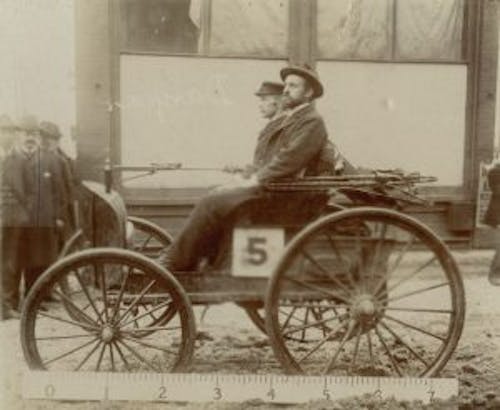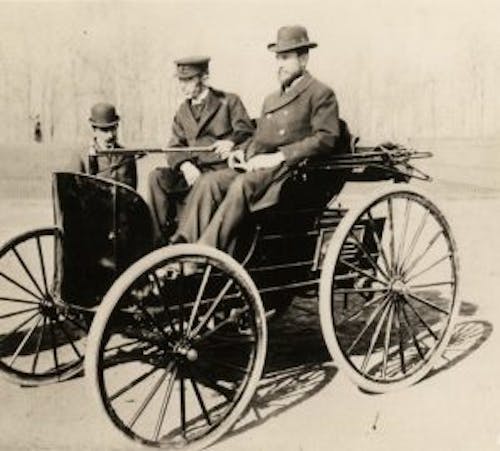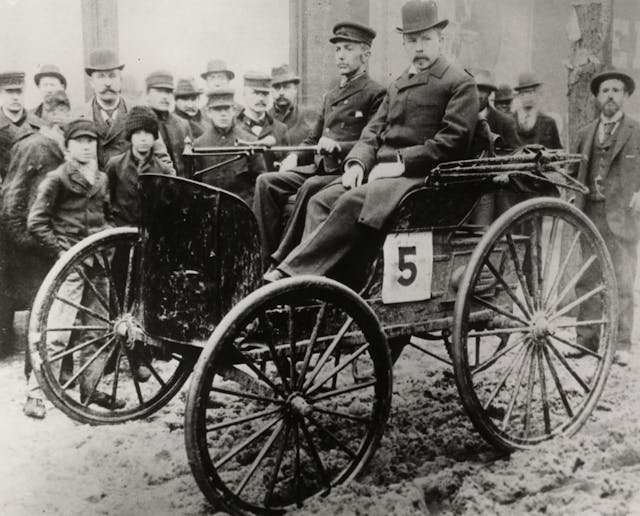The first-ever U.S. car race in 1895 was survival of the fittest
It’s been said that the first car race was held shortly after the second car was built, but since that’s impossible to document, we’ll go with what we know: 125 years ago this past weekend, the United States’ first official car race was held on cold and snowy Thanksgiving Day in Illinois. And the winner was … a Duryea Motor Wagon. Not a name that leaps to mind when you think of motorsports success, but certainly a key player in automotive history.
Although brothers Charles and Frank Duryea built motor cars together for less than 10 years before going their separate ways, they created a superior machine for the era. And in winning the Chicago Times-Herald “motocycle” race (yes, motocycle) on November 28, 1895, the two may have also created the “win on Sunday, sell on Monday” automotive business mentality.

The Duryea brothers completed their first one-cylinder, four-horsepower Duryea Motor Wagon in September, 1893, in Springfield, Massachusetts. The second Duryea Motor Wagon, built the following year, was the one entered in the legendary race.
Years later, while recalling how it all began—the race, not the car—founder H.H. Kohlsaat wrote in a 1941 issue of The Saturday Evening Post that the Chicago contest was inspired by the Paris-Rouen race he had seen in France in 1894. The stateside contest was originally planned for July 4, 1895, and Kohlsaat convinced the Times-Herald to put up a whopping $5000 in prize money—the equivalent of more than $135,000 today.
At Kohlsaat’s urging, President Grover Cleveland appointed a member of the War Department to supervise the event, based on the opinion that motor vehicles would be of the most use in the military and as commercial trucks. Some 60 contestants signed up, but applicants begged Kohlsaat for more time, so the race was pushed to Labor Day. It was later postponed again and rescheduled for Thanksgiving.
On November 2, a bit of a warm-up match was set between the Duryea and H. Mueller Benz’s Gasoline Motor Car (from Decatur, Illinois). Mueller was the only finisher, as the Duryea crashed into a ditch while trying to avoid a team of horses and broke a wheel. Repairs were made on the car in time to complete in the actual race 26 days later.

When November 28 arrived, it was greeted by two inches of snow and brisk wind, which whittled an already small field. That morning only six cars took off on an out-and back course from Chicago to Evanston, a race of 52.4 miles: the Duryea; three Benz cars (one sponsored by R.H. Macy’s department store in New York), and two electrics.
The tires of all six cars were wrapped in twine to improve traction. That didn’t do much for the electrics, whose batteries died almost immediately after the race began. With the entrants fighting through snowdrifts, the Duryea—with Frank at the wheel—passed the Macy’s car just past the halfway mark to take the lead—for good, as it turned out. Pushing to keep up, the Macy’s car first collided with a sleigh and then a streetcar, which damaged its steering. Another Benz also failed to finish.
Nine hours into the race, Kohlsaat wrote, Frank Duryea was experiencing trouble with his ignition, not to mention the snowdrifts. According to saturdayeveningpost.com, “he’d taken a wrong turn that added several miles to his route. But he was still ahead of Mueller, who was facing even greater difficulties. Before starting, Mueller had decided he would not just carry a referee, like all entrants, but an extra passenger as well. After spending the day in the back of the car, huddled against the freezing winds, the passenger was overcome by the cold. He was lifted out of the car and carried off for medical attention in a sleigh. Mueller kept driving, but he, too, was losing consciousness.”
By 6:30 p.m., Duryea was getting close to the finish line.
Kohlsaat wrote, “Lacking spectators, except here and there a solitary workman on his way home … the men on the motor gave vent to war whoops, cheers, cat calls, and other manifestations of joy over the victory they were winning.”
At 7:18 p.m., Frank Duryea crossed the finish line. “Almost two hours later, Mueller’s Benz came into view, but now the referee was driving. In one hand, he held the steering tiller and, in the other, held up Mueller, who’d collapsed from the cold.”

The Duryea Motor Wagon finished in 10 hours and 23 minutes—averaging a fraction over 5 mph—to win the race and the prize money, beating Mueller by 75 minutes. The Duryea brothers capitalized on their new-found fame and began commercial production the same year. By the end of 1896, they had sold an impressive 13 cars.
Frank left the company by 1900, disputing a proposed move to Detroit that never happened, and later partnered with a gunmaker to build Stevens-Duryea automobiles. Meanwhile, by 1905 Charles Duryea was employing 50 workers and manufacturing 60 cars a year. The success didn’t last, however, as his relationship with company shareholders was turbulent. The Duryea Motor Works eventually closed its doors in 1914, although Charles Duryea continued to build cars on his own.
His most famous, of course, was the second Motor Wagon, winner of the first American car race in 1895.


